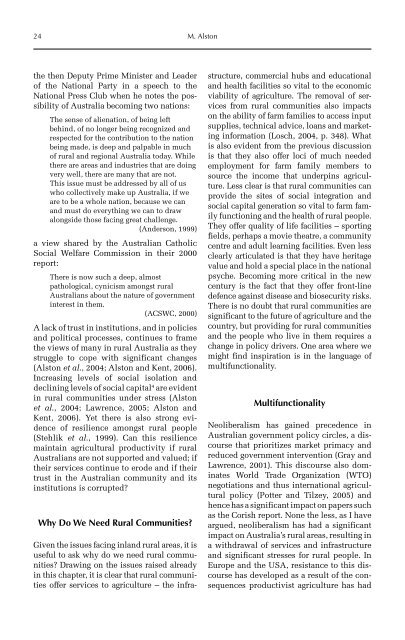Redesigning Animal Agriculture
Redesigning Animal Agriculture
Redesigning Animal Agriculture
You also want an ePaper? Increase the reach of your titles
YUMPU automatically turns print PDFs into web optimized ePapers that Google loves.
24 M. Alston<br />
the then Deputy Prime Minister and Leader<br />
of the National Party in a speech to the<br />
National Press Club when he notes the possibility<br />
of Australia becoming two nations:<br />
The sense of alienation, of being left<br />
behind, of no longer being recognized and<br />
respected for the contribution to the nation<br />
being made, is deep and palpable in much<br />
of rural and regional Australia today. While<br />
there are areas and industries that are doing<br />
very well, there are many that are not.<br />
This issue must be addressed by all of us<br />
who collectively make up Australia, if we<br />
are to be a whole nation, because we can<br />
and must do everything we can to draw<br />
alongside those facing great challenge.<br />
(Anderson, 1999)<br />
a view shared by the Australian Catholic<br />
Social Welfare Commission in their 2000<br />
report:<br />
There is now such a deep, almost<br />
pathological, cynicism amongst rural<br />
Australians about the nature of government<br />
interest in them.<br />
(ACSWC, 2000)<br />
A lack of trust in institutions, and in pol icies<br />
and political processes, continues to frame<br />
the views of many in rural Australia as they<br />
struggle to cope with significant changes<br />
(Alston et al., 2004; Alston and Kent, 2006).<br />
Increasing levels of social isolation and<br />
declining levels of social cap ital 4 are evident<br />
in rural communities under stress (Alston<br />
et al., 2004; Lawrence, 2005; Alston and<br />
Kent, 2006). Yet there is also strong evidence<br />
of resilience amongst rural people<br />
(Stehlik et al., 1999). Can this resili ence<br />
maintain agricultural productivity if rural<br />
Australians are not supported and valued; if<br />
their services continue to erode and if their<br />
trust in the Australian community and its<br />
institutions is corrupted?<br />
Why Do We Need Rural Communities?<br />
Given the issues facing inland rural areas, it is<br />
useful to ask why do we need rural communities?<br />
Drawing on the issues raised already<br />
in this chapter, it is clear that rural communities<br />
offer services to agriculture – the infra-<br />
structure, commercial hubs and educational<br />
and health facilities so vital to the economic<br />
viability of agriculture. The removal of services<br />
from rural communities also impacts<br />
on the ability of farm families to access input<br />
supplies, technical advice, loans and marketing<br />
information (Losch, 2004, p. 348). What<br />
is also evident from the previous discussion<br />
is that they also offer loci of much needed<br />
employment for farm family members to<br />
source the income that underpins agriculture.<br />
Less clear is that rural communities can<br />
provide the sites of social integration and<br />
social capital generation so vital to farm family<br />
functioning and the health of rural people.<br />
They offer quality of life facilities – sporting<br />
fields, perhaps a movie theatre, a community<br />
centre and adult learning facilities. Even less<br />
clearly articulated is that they have heritage<br />
value and hold a special place in the national<br />
psyche. Becoming more critical in the new<br />
century is the fact that they offer front-line<br />
defence against disease and biosecurity risks.<br />
There is no doubt that rural communities are<br />
significant to the future of agriculture and the<br />
country, but providing for rural communities<br />
and the people who live in them requires a<br />
change in policy drivers. One area where we<br />
might find inspiration is in the language of<br />
multifunctionality.<br />
Multifunctionality<br />
Neoliberalism has gained precedence in<br />
Australian government policy circles, a discourse<br />
that prioritizes market primacy and<br />
reduced government intervention (Gray and<br />
Lawrence, 2001). This discourse also dominates<br />
World Trade Organization (WTO)<br />
negotiations and thus international agricultural<br />
policy (Potter and Tilzey, 2005) and<br />
hence has a significant impact on papers such<br />
as the Corish report. None the less, as I have<br />
argued, neoliberalism has had a significant<br />
impact on Australia’s rural areas, resulting in<br />
a withdrawal of services and infrastructure<br />
and significant stresses for rural people. In<br />
Europe and the USA, resistance to this discourse<br />
has developed as a result of the consequences<br />
productivist agriculture has had










